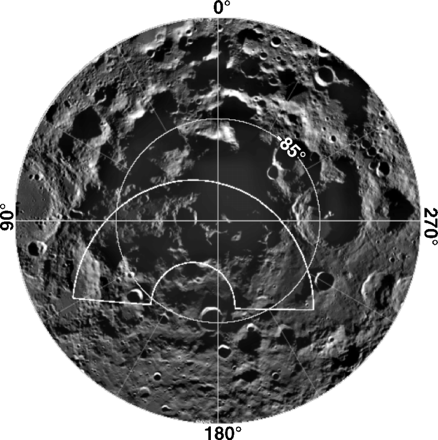12/11/96
CONTACT: Stanford University News Service (650) 723-2558
Stanford-developed radar technique used in reported discovery of ice on the moon
Last week a number of newspapers and newscasts reported the possible discovery of ice on the moon.
As the New York Times reported on Dec. 4, "Scientists think they have detected water on the moon, and suddenly visions of people living in lunar colonies and stopping off there to refuel on the way to Mars seem a little less farfetched."

Photo courtesy of Science
But Richard A. Simpson, a senior research associate at Stanford's Space, Telecommunications and Radioscience Laboratory (STARLab) who helped design the spacecraft experiment on which the announcement was based, is skeptical about the analysis.
"The identification [of ice], although positive, is not strong; without knowing exactly what [the researchers] did, it's difficult to say how well it will stand further testing," he said.
The origin of the coverage was a Dec. 3 news conference at the Pentagon. The analysis was made by a team of government and corporate scientists headed by Stewart Nozette from the Space Experiments Directorate at the U.S. Air Force Phillips Laboratory. It was based on a radar experiment performed with Clementine, a small Defense Department spacecraft launched in 1994. The group's claim appeared the week before in the journal Science under the title "The Clementine Bistatic Radar Experiment" but received little media attention.
"Those involved in Clementine would like to see more missions of the same type," Simpson said. "Discovery of ice on the moon is a significant event and should make backing for additional Clementines easier to get."
The bistatic radar technique has been called "poor man's radar." It was pioneered in the 1960s by Von R. Eshleman, Stanford professor emeritus of electrical engineering, and several of his students, including Simpson and G. Leonard Tyler, professor of electrical engineering. Several scientists in the former Soviet Union also contributed to its development.
The method uses a spacecraft's radio system to create the radar beam. The spacecraft antenna focuses the beam on the target area on the surface of a planet or satellite. The signals that are scattered toward Earth are collected by large radio dishes. By analyzing the nature of the scattered waves, scientists can determine important information about the surface, such as whether it contains ice.
Simpson got involved with Clementine in 1994 at the request of Nozette. The Clementine scientists felt there were good reasons to expect ice near the poles of the moon and asked Simpson whether it would be reasonable to do a bistatic radar experiment to confirm this, he recalled.
"I looked into the question and told them that, although ground-based radar experiments have higher sensitivity, the satellite would have an advantage of geometry, which is a key dimension in identifying ice," Simpson said. The mission scientists decided to give it a try and Simpson helped them set up the experiment.
Part of Simpson's skepticism regarding the current claim of ice at the moon's south pole is the fact that scientists looked at the same area four years ago with the large Arecibo radio telescope. "Arecibo has 1,000 times greater sensitivity than Clementine, yet they saw no evidence for ice," he said.
Tyler and Simpson submitted a proposal last year and have received funding to do an independent analysis of the Clementine data; they hope to have it completed by the end of next year.
-30-
By David F. Salisbury
